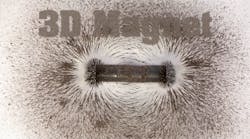Engineers at the Amess Laboratory’s Critical Materials Institute used laser 3D metal printing to turn permanent magnet material into an economical alternative to more expensive rare-earth neodymium iron boron (NdFeB) magnets. The researchers experimented with magnets 3D printed from different combinations of cobalt, iron, copper, and cerium (a less-expensive, more-plentiful rare earth material than neodymium). The researchers produced a range of compositions in samples that were printed using a 3D laser metal printer.
“The ceria-based alloy was a known magnetic material, but we wanted to revisit it to see if we could find exceptional magnetic properties,” says CMI scientist Ryan Ott. “With four elements, there is a vast number of compositions to explore, and3D printing greatly accelerates the search process.”
A range of magnets was created using 3D printing, cutting production time from weeks to a mere two hours. Samples with the most promising properties were identified; a second set of those samples were then made by conventional casting methods and compared to the 3D printed originals. This comparison confirmed that the chosen samples has a higher level of magnetism.
“It is very challenging to use laser printing to identify potential permanent magnet phases for bulk materials because of the need to develop the necessary microstructure,” says CMI scientist Ikenna Nlebedim. “But this research shows that additive manufacturing can be used to rapidly and economically identifying promising permanent magnet alloys.”

